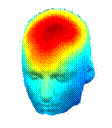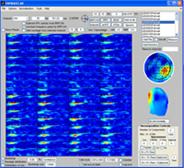|
Accessing Significance |
|
This area can be used to find the significance of the currently inspected measures. The confidence level can be specified and the significance level calculated when the ’Confidence’ button is down. For ERPCOH and ITPC the confidence level is calculated for a one tailed distribution, hence only what values exceed random activity are of interest. However, for all other measures the confidence is two tailed, i.e. what areas are significantly decreased compared to background and what are increased. Two form of significances are given. One is the significance that a given channel-time-frequency point is significant given that this is the only point of interest (hence uncorrected for multiple comparisons). The other treating all channel-time-frequency points in the montage plot as independent observations and calculating the significance that the maximum value of all these points by random exceeds the given significance level. If ‘Distribution of max’ is selected this latter form for significance is calculated.
Since random ERPCOH and ITPC activity is Rayleigh distributed these measures can rather than bootstrapping over baseline samples also be compared to the corresponding Rayleigh distribution which is computationally much faster. Since bootstrapping is quite slow there is an option when bootstrapping to assume all channel-frequency points are drawn from the same sample distribution only deviating by a multiplication of a constant (i.e. in amplitude). This assumption speeds up the bootstrapping process tremendously.
Notice: the distribution of the max is a conservative estimate since in general the time-frequency points are not independent. Furthermore, when selecting distribution of max a large bootstrap size is required since the value estimated depends strongly on the very tails of the bootstrapped distributions. When ‘Use all’ is selected the bootstrap sample is only drawn from the last dataset to reduce ram usage and avoid having to reload all datasets. |

|
Developed by Morten Mørup |
|
A tOOLbox FOR MULTI-CHANNEL TIME-FREQUENCY ANALYSIS |



